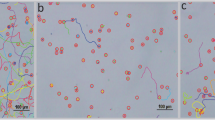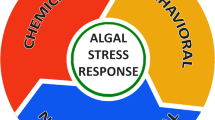Abstract
We examined the response of algal cells to laboratory-induced cadmium stress in terms of physiological activity, autonomous features (motility and fluorescence), adhesion dynamics, nanomechanical properties, and protein expression by employing a multimethod approach. We develop a methodology based on the generalized mathematical model to predict free cadmium concentrations in culture. We used algal cells of Dunaliella tertiolecta, which are widespread in marine and freshwater systems, as a model organism. Cell adaptation to cadmium stress is manifested through cell shape deterioration, slower motility, and an increase of physiological activity. No significant change in growth dynamics showed how cells adapt to stress by increasing active surface area against toxic cadmium in the culture. It was accompanied by an increase in green fluorescence (most likely associated with cadmium vesicular transport and/or beta-carotene production), while no change was observed in the red endogenous fluorescence (associated with chlorophyll). To maintain the same rate of chlorophyll emission, the cell adaptation response was manifested through increased expression of the identified chlorophyll-binding protein(s) that are important for photosynthesis. Since production of these proteins represents cell defence mechanisms, they may also signal the presence of toxic metal in seawater. Protein expression affects the cell surface properties and, therefore, the dynamics of the adhesion process. Cells behave stiffer under stress with cadmium, and thus, the initial attachment and deformation are slower. Physicochemical and structural characterizations of algal cell surfaces are of key importance to interpret, rationalize, and predict the behaviour and fate of the cell under stress in vivo.








Similar content being viewed by others
References
Becker W (2015) Advanced time-correlated single photon counting applications. Springer, New York. http://doi.org/10.1007/978-3-319-14929-5
Belghith T, Athmouni K, Bellassoued K, El Feki A, Ayadi H (2015) Physiological and biochemical response of Dunaliella salina to cadmium pollution. J Appl Phycol 28:991–999. https://doi.org/10.1007/s10811-015-0630-5
Butt HJ, Jaschke M (1995) Calculation of thermal noise in atomic force microscopy. Nanotech 6:1–7. https://doi.org/10.1088/0957-4484/6/1/001
Butt HJ, Cappella B, Kappl M (2005) Force measurements with the atomic force microscope: technique, interpretation and application. Surf Sci Rep 59:1–152. https://doi.org/10.1016/j.surfrep.2005.08.003
Campbell PGC, Errécalde O, Fortin C, Hiriart-Baer VP, Vigneault B (2002) Metal bioavailability to phytoplankton-applicability of the biotic ligand model. Comp Biochem Physiol C 133:189–206. https://doi.org/10.1016/S1532-0456(02)00104-7
Caricato R, Giordano ME, Schettino T, Lionetto MG (2018) Functional involvement of carbonic anhydrase in the lysosomal response to cadmium exposure in Mytilus galloprovincialis digestive gland. Front Physiol 9:319. https://doi.org/10.3389/fphys.2018.00319
Chorvatova A, Chorvat D Jr. (2014) Tissue fluorophores and their spectroscopic characteristics. In: Marcu L, French PMW, Elson DSV (eds) Fluorescence lifetime spectroscopy and imaging for tissue biomedical diagnostics. CRC Press Publ, Boca Raton, pp 47–84. https://doi.org/10.1201/b17018-5
Damaraju S, Schlede S, Eckhardt U, Lokstein H, Grimm B (2011) Functions of the water soluble chlorophyll-binding protein in plants. J Plant Physiol 168:1444–1451. https://doi.org/10.1016/j.jplph.2011.02.007
Einali A, Mazang-Ghasemi S, Valizadeh J, Noorozi M (2017) Metabolic responses and β-carotene production by the unicellular green alga Dunaliella salina exposed to leaf extracts. Acta Bot Brasilica 31:180–190. https://doi.org/10.1590/0102-33062017abb0002
EPA (2016) Aquatic life ambient water quality criteria for cadmium—2016. Aquatic Life Criteria—Cadmium Documents. EPA Web site. https://www.epa.gov/sites/production/files/2016-03/documents/cadmium-final-report-2016.pdf. Accessed 31 Oct 2018
Fisher NS, Boh M, Teyssi J-L (1984) Accumulation and toxicity of Cd, Zn, Ag, and Hg in four marine phytoplankters. Mar Ecol Prog Ser 18:201–213. https://doi.org/10.3354/meps018201
Folgar S, Torres E, Pérez-Rama M, Cid A, Herrero C, Abalde J (2008) Dunaliella salina as marine microalga highly tolerant to but a poor remover of cadmium. J Hazard Mater 165:486–493. https://doi.org/10.1016/j.jhazmat.2008.10.010
García-Ríos V, Freile-Pelegrín Y, Robledo D, Mendoza-Cózatl D, Moreno-Sánchez R, Gold-Bouchot G (2007) Cell wall composition affects Cd2+ accumulation and intracellular thiol peptides in marine red algae. Aquatic Toxicol 81:65–72. https://doi.org/10.1016/j.aquatox.2006.11.001
Guihéneuf F, Khan A, Tran L-SP (2016) Genetic engineering: a promising tool to engender physiological, biochemical, and molecular stress resilience in green microalgae. Front Plant Sci 7:400. https://doi.org/10.3389/fpls.2016.00400
Guillard RR (1975) Culture of phytoplankton for feeding marine invertebrates. In: Smith WL, Chanley MH (eds) Culture of marine invertebratae animals. Plenum, New York, pp 29–60. https://doi.org/10.1007/978-1-4615-8714-9_3
Hildebrand M, Doktycz MJ, Allison DP (2008) Application of AFM in understanding biomineral formation in diatoms. Pflüg Arch Eur J Phy 456:127–137. https://doi.org/10.1007/s00424-007-0388-y
Imani S, Rezaei-Zarchi S, Hashemi M, Borna H, Javid A, Zand AM, Abarghouei HB (2011) Hg, Cd and Pb heavy metal bioremediation by Dunaliella alga. J Med Plants Res 5:2775–2780
Israelachvili JN (1992) Intermolecular forces and surface forces. Academic Press Limited, New York. https://doi.org/10.1016/C2009-0-21560-1
Ivošević DeNardis N, Ružić I, Pečar-Ilić J, El Shawish S, Ziherl P (2012) Reaction kinetics and mechanicam models of liposome adhesion on charged interface. Bioelectrochemistry 88:48–56. https://doi.org/10.1016/j.bioelechem.2012.05.003
Ivošević DeNardis N, Pečar-Ilić J, Ružić I, Pletikapić G (2015) Cell adhesion and spreading at a charged interface: insight into the mechanism using surface techniques and mathematical modelling. Electrochim Acta 176:743–754. https://doi.org/10.1016/j.electacta.2015.07.068
Jauvert E, Palleau E, Dague E, Ressier L (2014) Directed assembly of living Pseudomonas aeruginosa bacteria on PEI patterns generated by nanoxerography for statistical AFM bioexperiments. ACS Appl Mater Interfaces 6:21230–21236. https://doi.org/10.1021/am506241n
Kim YK, Yoo WI, Lee SH, Lee MY (2005) Proteomic analysis of cadmium-induced protein profile alterations from marine alga nannochloropsis oculata. Ecotoxicology 14:589–596. https://doi.org/10.1007/s10646-005-0009-5
Lane TW, Saito MA, George GN, Pickering IJ, Prince RC, Morel FM (2005) Biochemistry: a cadmium enzyme from a marine diatom. Nature 435:42. https://doi.org/10.1038/435042a
LaRoche J, Bennett J, Falkowski PG (1990) Characterization of a cDNA encoding for the 28.5-kDa LHCII apoprotein from the unicellular marine chlorophyte, Dunalieila tertiolecta. Gene 95:165–171. https://doi.org/10.1016/0378-1119(90)90358-X
Martell AE, Smith RM, Motekaitis RJ (1998, 2004) NIST critically selected stability constants of metal complexes database. NIST Standard Reference Database, Vol. 46, Versions 5.0 and 8.0, Standard Reference Data Program, National Institute of Standards and Technology, U.S. Department of Commerce, Gaithersburg
Miazek K, Iwanek W, Remacle C, Richel A, Goffin D (2015) Effect of metals, metalloids and metallic nanoparticles on microalgae growth and industrial product biosynthesis: a review. Int J Mol Sci 16:23929–23969. https://doi.org/10.3390/ijms161023929
Nikookar K, Moradshahi A, Hosseini L (2005) Physiological responses of Dunaliella salina and Dunaliella tertiolecta to copper toxicity. Biomol Eng 22:141–146. https://doi.org/10.1016/j.bioeng.2005.07.001
Pillet F, Dague E, Pečar Ilić J, Ružić I, Rols M-P, Ivošević DeNardis N (2019) Changes in nanomechanical properties and adhesion dynamics of algal cells during their growth. Bioelectrochemistry. https://doi.org/10.1016/j.bioelechem.2019.02.011
Pinto E, Sigaud Kutner TCS, Leitão MAS, Okamoto OK, Morse D, Colepicolo P (2003) Heavy metal-induced oxidative stress in algae. J Phycol 39:1008–1018. https://doi.org/10.1111/j.0022-3646.2003.02-193.x
Pletikapić G, Berquand A, Mišić Radić T, Svetličić V (2012) Quantitative nanomechanical mapping of marine diatom in seawater using peak force tapping atomic force microscopy1. J Phycol 48:174–185. https://doi.org/10.1111/j.1529-8817.2011.01093.x
Ružić I (1982) Theoretical aspects of the direct titration of natural waters and its information yield for trace metal speciation. Anal Chim Acta 140:99–113. https://doi.org/10.1016/S0003-2670(01)95456-X
Ružić I, Pečar-Ilić J, Ivošević DeNardis N (2010) Mathematical model for kinetics of organic particle adhesion at an electrified interface. J Electroanal Chem 642:120–126. https://doi.org/10.1016/j.jelechem.2010.02.024
Sacan MT, Oztay F, Bolkent S (2007) Exposure of Dunaliella tertiolecta to lead and aluminum: toxicity and effects on ultrastructure. Biol Trace Elem Res 120:264–272. https://doi.org/10.1007/s12011-007-8016-4
Saha SK, Kazipet N, Murray P (2018) The carotenogenic Dunaliella salina CCAP 19/20 produces enhanced levels of carotenoid under specific nutrients limitation. BioMed Res Int. https://doi.org/10.1155/2018/7532897
Shafik MA (2008) Phytoremediation of some heavy metals by Dunaliella salina. Global J Environ Res 2:1–11
Shariati M, Yahyaabadi S (2006) The effects of different concentrations of cadmium on the growth rate and beta-carotene synthesis in unicellular green algae Dunaliella salina. Iran J Sci Technol Trans A 30:57–63. https://doi.org/10.22099/ijsts.2006.2731
Svetličić V, Ivošević N, Kovač S, Žutić V (2001) Charge displacement by adhesion and spreading of a cell. Bioelectrochemistry 53:79–86. https://doi.org/10.1016/S0302-4598(00)00115-X
Taha HM, Said HA, Abdel-aziz WM, Khaleafa AEF (2012) Effect of zinc and copper toxicity on growth and some metabolites of the green alga Tetraselmis chuii Butcher. Egypt J Exp Biol (Bot) 8:183–192
Teplicky T, Danisova M, Valica M, Chorvat D Jr, Marcek Chorvatova A (2017) Fluorescence properties of Chlorella sp. algae. AEEE 15:352–367. https://doi.org/10.15598/aeee.v15i2.2015
Tsuji N, Hirayanagi N, Okada M, Miyasaka H, Hirata K, Zenk MH, Miyamotoa K (2002) Enhancement of tolerance to heavy metals and oxidative stress in Dunaliella tertiolecta by Zn-induced phytochelatin synthesis. Biochem Biophys Res Commun 293:653–659. https://doi.org/10.1016/S0006-291X(02)00265-6
Tsuji N, Hirayanagi N, Iwabe O, Namba T, Tagawa M, Miyamoto S, Miyasaka H, Takagi M, Hirata K, Miyamoto K (2003) Regulation of phytochelatin synthesis by zinc and cadmium in marine green alga, Dunaliella tertiolecta. Phytochem 62:453–459. https://doi.org/10.1016/S0031-9422(02)00559-9
van den Berg CMG (1982) Determination of copper complexation with natural organic ligands in seawater by equilibration with MnO2 I. Theory. Mar Chem 11:307–322. https://doi.org/10.1016/0304-4203(82)90028-7
Visviki J, Rachlin W (1994) Acute and chronic exposure of Dunaliella salina and Chlamydomonas bullosa to copper and cadmium: effects on ultrastructure. Arch Environ Contam Toxicol 26:154–162. https://doi.org/10.1007/BF00224798
Wan L, Zhang H (2012) Cadmium toxicity—effects on cytoskeleton, vesicular trafficking and cell wall construction. Plant Signal Behav 7:345–348. https://doi.org/10.4161/psb.18992
Wang M-J, Wang W-X (2009) Cadmium in three marine phytoplankton: accumulation, subcellular fate and thiol induction. Aquat Toxicol 95:99–107. https://doi.org/10.1016/j.aquatox.2009.08.006
Wikfors GH, Neeman A, Jackson PJ (1991) Cadmium-binding polypeptides in microalgal strains with laboratory-induced cadmium tolerance. Mar Ecol Prog Ser 79:163–170. https://doi.org/10.3354/meps079163
Zamani N, Rasekh F, Ghahremanpour MM, Moradshahi A, Kholdebarin B (2009) Physiological responses of Dunaliella tertiolecta to Hg2+-induced oxidative stress. Iran J Sci Technol Trans A 39:65–74. https://doi.org/10.22099/ijsts.2009.2203
Zmiri A, Ginzburg BZ (1983) Extracellular space and cellular sodium content in pellets of Dunaliella parva Dead Sea 75. Plant Sci Lett 30:211–218. https://doi.org/10.1016/0304-4211(83)90220-1
Žutić V, Kovač S, Svetličić V (1993) Heterocoalescence between organic microdroplets and charged conductive interface. J Electroanal Chem 349:173–186. https://doi.org/10.1016/0022-0728(93)80171-D
Žutić V, Svetličić V, Ivošević N, Hozić A, Pečar O (2004) Northern Adriatic mesocosm experiment Rovinj 2003: dynamics of organic microparticles studied by the electrochemical technique. Period Biolog 106:67–74
Acknowledgements
This work was conducted and supported by project Algal cell biophysical properties as markers for environmental stress in aquatic systems (ID 21720055) funded through the International Visegrad Fund. AMH acknowledges support from the Integrated Initiative of European Laser Infrastructures LASERLAB-EUROPE IV (H2020 grant agreement no. 654148). AW acknowledges funding from the Austrian Science Fund (project number P29562N28). We would like to thank (i) Tarzan Legović for discussing cell motility analysis with us, (ii) Jagoba Iturri and José Luis Toca-Herrera for discussing cell nanomechanics with AW and (iii) project partner Josef Sepitka for his participation and interest in this work. The authors acknowledge networking effort within COST Action CA15126 ARBRE MOBIEU.
Author information
Authors and Affiliations
Corresponding author
Additional information
Publisher's Note
Springer Nature remains neutral with regard to jurisdictional claims in published maps and institutional affiliations.
Electronic supplementary material
Below is the link to the electronic supplementary material.
Rights and permissions
About this article
Cite this article
Ivošević DeNardis, N., Pečar Ilić, J., Ružić, I. et al. Algal cell response to laboratory-induced cadmium stress: a multimethod approach. Eur Biophys J 48, 231–248 (2019). https://doi.org/10.1007/s00249-019-01347-6
Received:
Revised:
Accepted:
Published:
Issue Date:
DOI: https://doi.org/10.1007/s00249-019-01347-6




